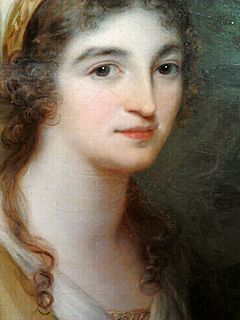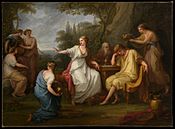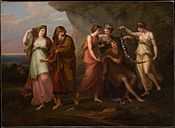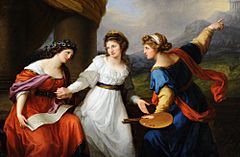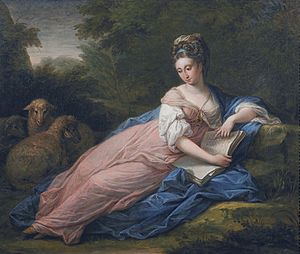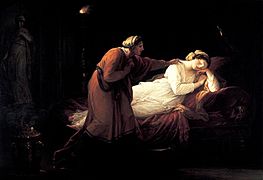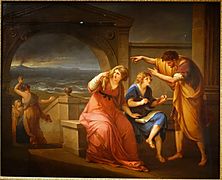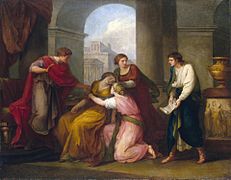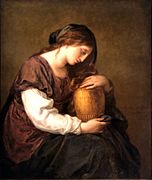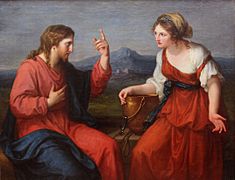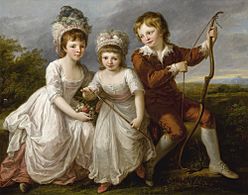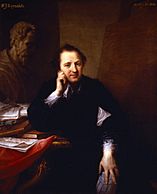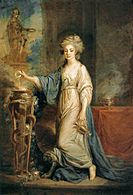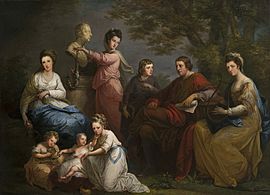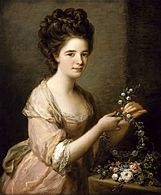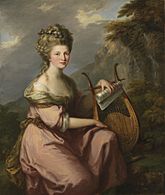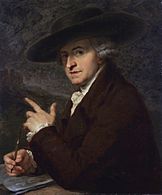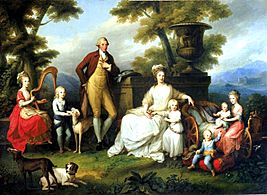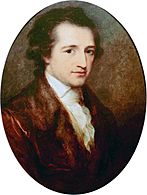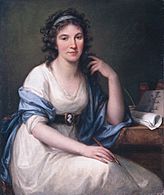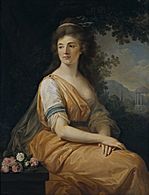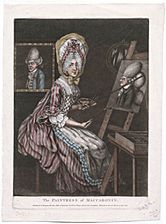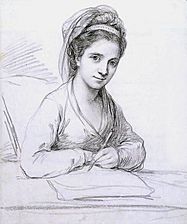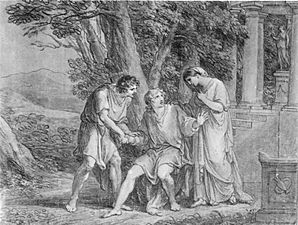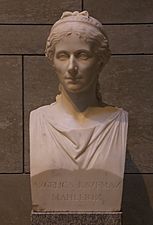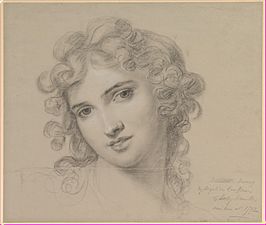Angelica Kauffman facts for kids
Quick facts for kids
Angelica Kauffman
|
|
|---|---|

Self-portrait by Kauffman, 1770–75
|
|
| Born |
Maria Anna Angelika Kauffmann
30 October 1741 |
| Died | 5 November 1807 (aged 66) |
| Nationality | Swiss |
| Known for | Painting |
| Movement | Neoclassicism |
| Spouse(s) |
Frederick de Horn
(m. 1767; sep. 1768)Antonio Zucchi
(m. 1781; died 1795) |
Maria Anna Angelika Kauffmann (30 October 1741 – 5 November 1807), usually known as Angelica Kauffman, was a talented Swiss painter. She was a leading artist in the Neoclassicism style. This art style used ideas from ancient Greece and Rome.
Angelica had a very successful career in London and Rome. She is mostly remembered for her history paintings. But she was also great at painting portraits, landscapes, and decorations. In 1768, she became one of the first two female founding members of the Royal Academy in London. The other woman was Mary Moser.
Contents
Early Life and Artistic Beginnings
Angelica Kauffman was born in Chur, Switzerland. Her family moved several times when she was young. They lived in Italy and Austria. Her father, Joseph Johann Kauffmann, was a painter. He taught Angelica everything he knew. She worked as his helper from a young age.
Angelica was a child prodigy, meaning she was extremely talented very early on. She learned several languages quickly, including German, Italian, French, and English. She was also a gifted musician. But she chose to focus on art. By age twelve, she was already known as a painter. Important people like bishops and nobles asked her to paint their portraits.
In 1754, her mother passed away. Her family then moved to Milan. Angelica made many long visits to Italy. She joined the Accademia di Belle Arti di Firenze in 1762. In Florence, she discovered the Neoclassical painting style. She moved to Rome in 1763. There, she met many British people. She kept improving her English and her portrait painting skills.
Later, she moved to Naples. She studied works by famous old masters there. Her first painting was shown in a public exhibition in London. She visited Rome again in 1764. She also traveled to Bologna and Venice. Everyone admired her talent and charm. A famous writer named Johann Joachim Winckelmann praised her. He said she spoke many languages well. He also said she was beautiful and sang wonderfully. In 1765, her art was shown in England. Soon after, she moved to England and became a top artist.
Years in Great Britain
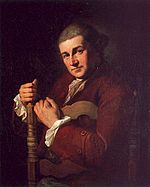
While in Venice, Angelica was asked by Lady Wentworth to come to London. Lady Wentworth was the wife of the British ambassador. One of Angelica's first paintings in London was a portrait of the famous actor David Garrick. This painting was shown the same year she arrived.
Lady Wentworth helped Angelica meet important people. The royal family especially liked her work. Her closest friend was Sir Joshua Reynolds, a very famous painter. He often mentioned her in his notes. In 1766, he painted her portrait. She painted his portrait in return.
In 1767, Angelica married a man who used a false name. They separated the next year. Sir Joshua Reynolds likely helped her become a founding member of the Royal Academy. This was a new art institution. In the first Royal Academy catalog in 1769, her name appeared with "R.A." after it. This showed she was a Royal Academician. She was one of only two women to receive this honor. She showed several classical paintings there.
In 1771, she spent several months in Ireland. She was a guest of the Lord Lieutenant of Ireland. She painted many portraits there. Her notable Irish portraits include those of Philip Tisdall and his wife Mary. She also painted Henry Loftus, 1st Earl of Ely and his family.
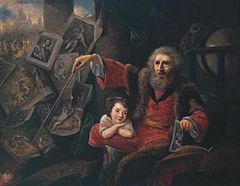
Her friendship with Reynolds was sometimes criticized. In 1775, another artist named Nathaniel Hone the Elder painted a picture called The Conjurer. Some people thought it made fun of Sir Joshua Reynolds. The Royal Academy did not accept this painting.
From 1769 to 1782, Angelica showed her art every year at the Royal Academy. Sometimes she sent as many as seven paintings. These usually showed classical stories or ideas. One famous painting was Leonardo expiring in the Arms of Francis the First (1778).
In 1773, the Royal Academy asked her to help decorate St Paul's Cathedral. This plan was never finished. But she did paint the Academy's old lecture room at Somerset House.
History Painting
Angelica Kauffman painted many portraits and self-portraits. But she saw herself mainly as a history painter. This was unusual for a woman artist in the 1700s. History painting was seen as the most important and highest form of art. It was also the most profitable.
The Royal Academy, led by Sir Joshua Reynolds, tried hard to promote history painting in Britain. However, British people were more interested in buying portraits and landscapes. Angelica was popular in Britain, but she was disappointed. She felt the British did not care enough about history painting. So, she left Britain for Rome. In Rome, history painting was more respected and supported.
History painting meant painting scenes from history, myths, literature, and religious stories. To do this, artists needed to know a lot about these subjects. They also needed to study art theory and human anatomy. Most women were not allowed to get this kind of training. But Angelica managed to become a successful history painter.
Later Years in Rome
In 1781, Angelica married Antonio Zucchi. He was an artist from Venice who lived in England. Her first husband had passed away, and she had been separated from him for a long time. Soon after, she moved to Rome. There, she became friends with famous people like Johann Wolfgang von Goethe. She lived in Rome for another 25 years. She kept much of her fame and respect.
In 1782, Angelica's father died. Her husband, Antonio Zucchi, died in 1795. In 1794, she painted Self-Portrait Hesitating Between Painting and Music. This painting shows the difficult choice she made. She had to choose between music and painting as her main career. She chose painting to honor her mother.
She continued to send her art to the Royal Academy in London sometimes. Her last exhibit was in 1797. After this, she painted less. She died in Rome in 1807. She had a grand funeral led by the famous sculptor Canova. Many artists and important people followed her to her tomb. Two of her best paintings were carried in the procession. This was a great honor, like the funeral of Raphael.
Legacy
By the time she died, Angelica Kauffman was a very famous artist. This is why her funeral was so special. It was designed by the well-known Neoclassical sculptor Antonio Canova. He based it on the funeral of the Renaissance master Raphael.
Even in 1911, rooms decorated with her artwork could still be seen in many places. There was a portrait of the Duchess of Brunswick at Hampton Court. The National Portrait Gallery had a self-portrait by her.
Other paintings by her were in Paris, Dresden, and the Hermitage in St Petersburg. You could also find her art in Munich, Tallinn, and Graz. The Munich example was another self-portrait. There was a third one in the Uffizi in Florence. Some of her works from private collections were shown at Burlington House.
Angelica Kauffman is also known for the many prints made from her designs. Artists like Luigi Schiavonetti and Francesco Bartolozzi made these prints. Bartolozzi's prints were very popular with art collectors. Charles Willson Peale, a famous American artist, named one of his daughters Angelica Kauffman Peale.
A book about Angelica Kauffman was published in 1810 by Giovanni Gherardo De Rossi. This book also inspired a novel by Léon de Wailly in 1838. It also led to the novel "Miss Angel" by Anne Isabella Thackeray Ritchie in 1875.
The writer Miranda Miller wrote a novel called Angelica, Paintress of Minds. It is written as if Angelica Kauffman herself wrote it. It tells her life story from her last days in Rome.
The Angelika Kauffmann Museum
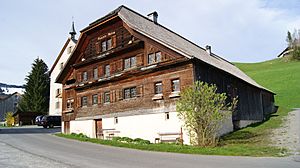
The Angelika Kauffmann Museum opened in 2007. It is in Schwarzenberg, Austria. This area was home to her father. The museum has new exhibitions each year. These shows focus on different parts of her art. In 2019, an exhibition showed many of her paintings for the first time. This is because many of her works are owned by private collectors. The museum is in an old farmhouse from 1556. It shows the typical building style of the region.
Galleries
History painting
Portraits
-
Goethe [at 38 years] (1787)
Miscellaneous
-
Scene from the 1802 première in Weimar of Goethe's Iphigenia in Tauris, with Goethe himself as Orestes in the centre.
Exhibitions
- Retrospective Angelika Kauffmann (270 works), shown in Düsseldorf, Munich, and Chur (1998–1999).
- Angelica Kauffman: Unknown Treasures from Vorarlberg Private Collections, shown at the Vorarlberg Museum and the Angelika Kauffmann Museum, Schwarzenberg, Austria (2019).
See also
 In Spanish: Angelica Kauffmann para niños
In Spanish: Angelica Kauffmann para niños


